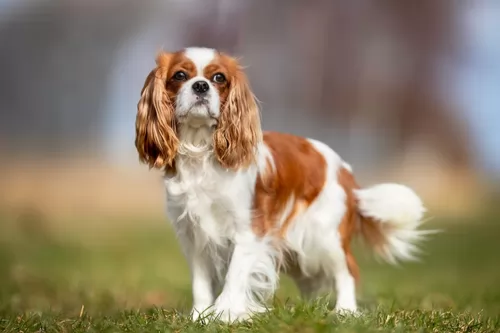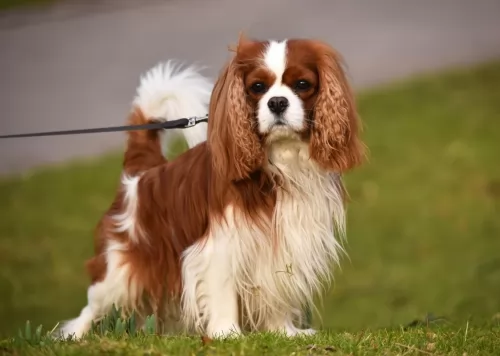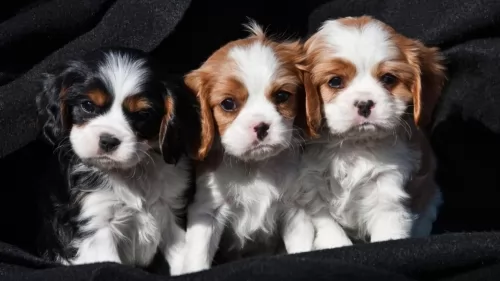 Petzlover
Petzlover King Charles Spaniel is originated from United Kingdom but Korean Mastiff is originated from South Korea. King Charles Spaniel may grow 48 cm / 18 inches shorter than Korean Mastiff. King Charles Spaniel may weigh 66 kg / 145 pounds lesser than Korean Mastiff. King Charles Spaniel may live 4 years more than Korean Mastiff. Both King Charles Spaniel and Korean Mastiff has same litter size. Both King Charles Spaniel and Korean Mastiff requires Moderate Maintenance.
King Charles Spaniel is originated from United Kingdom but Korean Mastiff is originated from South Korea. King Charles Spaniel may grow 48 cm / 18 inches shorter than Korean Mastiff. King Charles Spaniel may weigh 66 kg / 145 pounds lesser than Korean Mastiff. King Charles Spaniel may live 4 years more than Korean Mastiff. Both King Charles Spaniel and Korean Mastiff has same litter size. Both King Charles Spaniel and Korean Mastiff requires Moderate Maintenance.
 Classified as a toy breed, the King Charles Spaniel is a small, pure breed dog that originated in the United Kingdom. The dog was named after King Charles II of Britain.
Classified as a toy breed, the King Charles Spaniel is a small, pure breed dog that originated in the United Kingdom. The dog was named after King Charles II of Britain.
The dog actually has quite a long, illustrious history. People mistake them for the Cavalier King Charles Spaniel, but they are 2 different breeds, just sharing the same coat colors.The King Charles Spaniel was crossbred with the Pug early in the 19th century to shorten the length of the dog's nose.
With a face similar to that of the Pug, it is thought that these toy spaniels may have originated in the Far East.The earliest recorded pictures of toy spaniels in England were in paintings of Queen Mary 1 and King Philip.
 This large breed dog is also known as the Mee Kyun Dosa. In spite of his huge size, he isn’t aggressive at all and is bred to be a companion dog.
This large breed dog is also known as the Mee Kyun Dosa. In spite of his huge size, he isn’t aggressive at all and is bred to be a companion dog.
He was originally developed to be a working dog. The dog was developed in the late 1800’s from European and Asian working breeds. Those interested in dog breeds suspected that a crossing of the Japanese Tosa-Inu with the Neapolitan Mastiff and the Dogue de Bordeaux brought about the breed. They also thought that the Saint Bernard and English Mastiff were brought in later on as well.
These large molosser dogs have been developed through years of inbreeding. It is one of the biggest dogs in Korea.
 The King Charles Spaniel is a medium sized dog that stands at roughly 23 – 28cm and weighs anything from 3 to 8kg. He is smaller than the Cavalier King Charles.
The King Charles Spaniel is a medium sized dog that stands at roughly 23 – 28cm and weighs anything from 3 to 8kg. He is smaller than the Cavalier King Charles.
He has a long coat which can be white, black and tan or a reddish-brown color. He has a domed head with a short, turned up nose and 'squashed' face similar to the pug. The eyes are large and dark and also protruding. The ears are set low and are long and floppy and the tail, once docked, is now left long and feathery.
Friendly, while being somewhat reserved, the King Charles Spaniel is looked upon as a lap dog as he loves to spend time indoors with his human family.
He isn't particularly energetic, but will still need some exercise like ball games and going on a walk. With training and socialization he becomes quiet and obedient and is known as a popular therapy dog. They are kind and loving with kids and pets in the home.
 You can’t help but stare at the Korean Mastiff because of his strong, muscular neck of loose skin that forms dewlaps. His face is wrinkled and he has a cumbersome, sluggish gait.
You can’t help but stare at the Korean Mastiff because of his strong, muscular neck of loose skin that forms dewlaps. His face is wrinkled and he has a cumbersome, sluggish gait.
He is a large dog standing at anything between 59 to 76cm in height, both male and female. He can weigh between 65 to 74kg. He is noticeable because of his fairly loose fitting coat, which is short and smooth and which is a rich, shiny reddish, orange or brown colour.
The nose of the dog is broad and dark, the ears soft and floppy and he has eyes which are set wide apart.
The Korean Mastiff is reserved with strangers but he is friendly and even tempered with his human family, making an ideal pet.
He is looked upon as a gentle giant, being an oversized playmate for children and he also tolerates other pets in the home.
He isn't an overly energetic dog, but that doesn't mean he shouldn't be exercised. He will need long walks to avoid him putting on weight.
 Your King Charles Spaniel is such a joy to have in the home and because he is intelligent he will easily learn some simple commands too.
Your King Charles Spaniel is such a joy to have in the home and because he is intelligent he will easily learn some simple commands too.
He wants to please you and be with you wherever you go. He is a social dog and thrives on your attention, and if you open your home and your heart to this sweet dog, you’re going to have a devoted, loving, loyal friend beside you every day.
 Your huge Korean Mastiff is a good natured dog who isn’t aggressive. He loves being with his human family and makes a particularly good pet when he has been trained and socialized.
Your huge Korean Mastiff is a good natured dog who isn’t aggressive. He loves being with his human family and makes a particularly good pet when he has been trained and socialized.
He likes a firm but fair owner who takes a leader-of-the-pack role. In spite of his largeness and sluggishness, he can be quite agile and makes a good watchdog too.
All round, the Korean Mastiff, known as a gentle giant, is capable of making you a splendidly friendly, loving canine companion.
 The eye problems that you might need to know about with a King Charles Spaniel are entropian, cataracts and corneal dystrophy.
The eye problems that you might need to know about with a King Charles Spaniel are entropian, cataracts and corneal dystrophy.
Heart conditions could include mitral valve disease where the blood flows backwards through the chambers of the heart, leading to congestive heart failure.
The King Charles Spaniel is a brachycephalic breed and these dogs can have upper airway problems. Breathing difficulties can also occur because of an abnormally small windpipe which is a characteristic common to brachycephalic breeds. You may notice rapid breathing with your dog , snoring, frequent panting, coughing and difficulty with swallowing.
As a dog owner, you have a responsibility to your pet. He will need to visit the veterinarian for all his puppy vaccinations as well as other vaccinations as an adult dog. He will also need to be de-wormed.
If you don’t want him or her becoming a parent, make sure your pet is neutered or spayed. If your pet is showing signs of an illness that he doesn’t get over quickly, get him immediately to the vet.
 Treat your big Mastiff dog like the wonderful fur-child he is and make sure your attend to all his medical needs to avoid pain and discomfort for him.
Treat your big Mastiff dog like the wonderful fur-child he is and make sure your attend to all his medical needs to avoid pain and discomfort for him.
Cherry eye is a fairly common health issue with this breed. It affects the tear gland of the third eyelid, and if left untreated, can lead to ongoing eye problems.
All dogs have a third eyelid, as well as two tear producing glands to lubricate the eyes. Its an important protective component to eye health in dogs. When the connective tissue that holds the gland in place is damaged or weak, there is a red protrusion of the gland from the lower eye. This is a congenital disorder. Don’t ignore it, but get your pet to the vet so you can catch it early.
Canine bloat, known as gastric dilatation and volvulus can be a killer disease for your pet, more so with deep-chested, large breeds.
Gas accumulation is known as bloat, and its the accumulation of gas which can cause the stomach to rotate. A dog can go into shock from bloat. The reason for this is that the stomach expands, putting pressure on veins. Blood can’t flow as it should and the blood supply gets cut off to the stomach.
Your dog could be vomiting, restless, the stomach hard and bloated or he may be drooling. Dogs who gobble their food down and eat just one large meal a day have an increased susceptibility to GDV than other dogs.
The wrong ingredients of a dog’s diet can also contribute to bloat. High quality food and feeding your pet smaller meals can help.
 Your King Charles Spaniel has a long, silky coat that will require brushing twice a week to control shedding and keep his coat free of matting.
Your King Charles Spaniel has a long, silky coat that will require brushing twice a week to control shedding and keep his coat free of matting.
His nails will also require regular trimming to ensure they don’t hook on anything. His long ears are also prone to ear infection, so be sure to check them inside and out for ticks and fleas and to also remove excess wax and dirt.
Teeth should also be regularly brushed with canine toothbrush and toothpaste.
Be sure to keep your King Charles Spaniel content and healthy by ensuring he goes on a long walk and that you play with him to build a strong bond between you and to ensure he doesn’t become bored.
Excellent, quality food is important for your spaniel. The best dog food manufacturers have age- and breed-specific formulas and there is the perfect one for your King Charles Spaniel. Homemade food is also excellent for this dog and you can add some cooked chicken, brown rice and vegetables into his kibble as a nutritious treat.
Make sure your spaniel has a warm, dry, peaceful place to sleep and wash the bedding regularly to keep him healthy and happy.
Ensure he always has a cool, fresh bowl of drinking water nearby.
 A Korean Mastiff is an easy dog to groom with his short smooth coat. He is a moderate shedder so a brush twice a week will be sufficient to maintain the shiny, smooth condition of his coat.
A Korean Mastiff is an easy dog to groom with his short smooth coat. He is a moderate shedder so a brush twice a week will be sufficient to maintain the shiny, smooth condition of his coat.
Because the dog has lots of skin and folds, these folds will need to be washed and kept clean as grime can collect.
While you're busy attending to his skin check his nails too and check inside and outside his ears for signs of redness and irritation.
Puppies use up more energy than mature adults, requiring a diet of good quality protein. Dogs that have been spayed or neutered will require less calories as will senior dogs.
Korean Mastiffs require high quality nutrition, and if its dry kibble, make sure its the best brand. Mix in some home-made food such as cooked chicken, brown rice and vegetables from time to time as well as some raw meat occasionally.
Protein and fat from good sources are top ingredients for your Korean Mastiff. Avoid food with allergens such as corn and wheat, sweeteners, preservatives and colorants.
Make sure your large pet has constant access to fresh water.